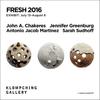Iconic Flag Painting by Childe Hassam Gifted to New-York Historical Society
- NEW YORK, New York
- /
- March 28, 2016
Dr. Louise Mirrer, President and CEO of the New-York Historical Society, announced that Chairman Emeritus Richard Gilder has donated to New-York Historical a monumental flag painting by the acclaimed American Impressionist painter Childe Hassam—one of the last of the beloved series of Hassam flag canvases still in private hands.
The Fourth of July, 1916 (The Greatest Display of the American Flag Ever Seen in New York, Climax of the Preparedness Parade in May) depicts Fifth Avenue bedecked with dozens of American flags in celebration of Independence Day exactly 100 years ago, when New Yorkers rallied with patriotic fervor to support the “Preparedness Movement” in anticipation of the nation’s inevitable entry into the Great War in Europe. The bravura canvas, more than three feet by two feet in size, is only the second in Hassam’s renowned Flag series of approximately 30 works and was initially inspired by a parade that took place in May 1916. The Fourth of July, 1916 will go on view at the New-York Historical Society later this year in a new first-floor gallery to be named for Mr. Gilder and his wife Lois Chiles.
“Twelve years ago, on the eve of New-York Historical’s bicentennial, Richard Gilder boldly envisioned our institution as New York’s great destination for American history,” said Dr. Mirrer. “Under his chairmanship, the institution began working tirelessly to achieve this ambitious goal. This marvelous ‘flag’ painting by Childe Hassam, the artist’s most prized and celebrated work and a particular favorite of the donor, at once celebrates our achievements in carrying out Mr. Gilder’s vision and reaffirms his unparalleled, and ongoing, role in our success. As we look now to commemorating the painting’s 100th anniversary by giving it pride of place in our newly-named Richard Gilder and Lois Chiles Hall, we take enormous pleasure in the expression of pride and affection for New-York Historical that this extraordinary gift conveys. Once again, we sincerely thank Dick Gilder for his great generosity and heartening faith in our institution.”
“It is both a pleasure and an honor to donate this masterpiece to a museum that continues to aspire to the traditions the painting so powerfully conveys: the confluence of New York history and American history,” said Mr. Gilder. “It is time to make this picture available to the public so that visitors to the New-York Historical Society will enjoy the painting as much as my wife, Lois, and I have.”
Childe Hassam (1859–1935), a pioneer of American Impressionism, began his career in Boston, supporting himself with commissioned illustrations while creating his own work in oil and watercolor. In 1886, he moved to Paris to study at the Académie Julian, where he became increasingly absorbed by the works of French Impressionists. He returned to the United States three years later and began a lifelong residency in New York. Hassam received critical acclaim and commercial success. During his career, he produced more than 2,000 oils, watercolors, and pastels, along with a large body of prints. He also contributed six paintings to the Armory Show of 1913.
Hassam was a committed supporter of the United States preparedness movement, which advocated for a strengthened military to bolster the nation’s defense capability after the outbreak of war in Europe in July 1914. The movement had been originally opposed by President Woodrow Wilson, who urged that the country remain neutral, although his strong pacifist sentiment began to soften following the sinking of theLusitania, which was carrying American passengers, by German U-boats in May 1915.
Advocates of the preparedness cause staged parades in cities all over the country from 1914 until 1916. One such parade in May 1916―up Broadway and Fifth Avenue, led by an enormous, 95-foot flag and lasting over 11 hours―inspired Hassam to begin working on a series of works, which he painted over the course of three years from 1916 to 1918. A more elaborate and spectacular parade took place on the Fourth of July that year, inspiring the Gilder painting. The 36-by-26-inch Fourth of July, 1916 was the second in Hassam’s series.
The full title of the painting―The Fourth of July, 1916 (The Greatest Display of the American Flag Ever Seen in New York, Climax of the Preparedness Parade in May)―conflates the annual celebration of the country’s independence with the sentiment of nationalistic fervor created by the preparedness movement. The presence of skyscrapers and a double-decker bus place the scene on Fifth Avenue; the exact location is left unknown, however, perhaps implying that the entire boulevard had been transformed into a glorious display of pageantry.
When the painting was first displayed at the Montross Gallery in New York, the art critic of the Christian Science Monitor declared himself awed by its “sea of stars and stripes floating to the breeze from the skyscrapers on either side of the great American thoroughfare,” almost giddily describing the picture as “the climax that fairly shouts hurrah for Old Glory!” The painting, which was formerly in the collection of Frank Sinatra, was lent by Mr. Gilder to the 2004 Metropolitan Museum of Art exhibition Childe Hassam: American Impressionist. In the catalogue for that show, curator of American Art H. Barbara Weinberg noted that most of Hassam’s large-scale flag paintings boasted “dynamic compositions, none more so than the second work in the series, The Fourth of July, 1916.”
Critics of the day praised Hassam’s flag compositions lavishly. Noted The New York Times (June 16, 1918): “There is something in the conjunction of flags and city buildings that stimulates the imagination. One gets from it the idea of the city, a place built by men for their satisfaction and activities, to be defended with passion from a destructive enemy. No fairer sight than the blonde wide lane of Fifth Avenue, with its innumerable banners, can well be imagined, and Mr. Hassam has precisely the vision and palette to commemorate its effect of stern gayety, of laughing beauty marching fearlessly to victory.”
In the spring of 2017, the Museum will host a traveling exhibition, World War I and American Art, which coincides with the 100th anniversary of the U.S. entry into the Great War.






100x100_c.jpg)






![Peter Paul Rubens (Flemish, 1577–1640), After Titian (Tiziano Vecelli) (Italian [Venetian], c. 1488–1576), Rape of Europa, 1628–29. Oil on canvas, 71 7/8 x 79 3/8 in. Peter Paul Rubens (Flemish, 1577–1640), After Titian (Tiziano Vecelli) (Italian [Venetian], c. 1488–1576), Rape of Europa, 1628–29. Oil on canvas, 71 7/8 x 79 3/8 in.](/images/c/e2/2e/Jan20_Rape_of_Europa100x100_c.jpg)


